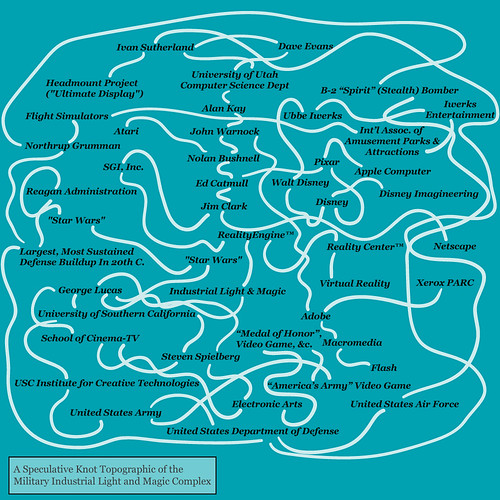
Via Fabien on the 7.5th Floor, I came across an illustration by Karen Martin starting to map the field of Urban Computing. It’s not a field, of course — closer to a large set of intersecting practices and broader disciplines swirling about those practices. Two things to be said. First about visualizations and illustrations of complex social-practice-fields. Second about urban computing (whatever that is, and whyever that is.)
What I find most compelling here is the absence — difficult to capture, to be sure — of the messiness that is definitely part of what is referred to as “urban computing”, which I wouldn’t even try to define, except in a rather messy diagram, much messier than Karen’s valiant work.
Knots, intersections, tangles and generally messy illustrations are, I’m sure, very unpopular, particularly with design’s general fetish of clean lines and the Tufte aesthetic of making complex visualizations all tidy and Tufte.
I’m not an illustrator or visualization guy by any stretch, but I’m much more agreeable, and prone to appreciate the messy illustration of what are complex engagements of social practices. This was my one effort to represent the military-industrial light and magic complex — the swirl of history, time, politics, national security and the entertainment enterprise. No attempt to be orderly and legible in the Tufte sense of things. It’s a complex “eco-system” with layers and knots and disorderly eddies (not flows..please..) of power and aspiration and money. Why organize that with bullets and linear connections? Simplifications erase the beast, leaving just shards of bone to be imaginarily cobbled back into a fictitious whole. What produces meaning, in my mind, is not so much names of practices, or companies or individual participants, but rather the ways in which the imbroglios form, power is manipulated and deployed — the process of deploying “resources” to create the names and to give them “stickiness” and the holding power that then makes them, you know — a “given.”
Latour sums this notion up eloquently, and there’s lots more to be said, at some other time, I’m sure.
“..we do not find all explanations in terms of inscription equally convincing,
but only those that help us to understand how the mobilization and mustering of new
resources is achieved. We do not find all explanations in terms of social groups, interests or economic trends, equally convincing but only those !that offer a specific mechanism to sum up “groups”, “interests”, “money”!and “trends”: mechanisms which, we believe, depend upon the manipulation of paper, print, images and so on.” [“Visualisation and Cognition: Drawing Things Together”].
In an “urban computing” terrain map, the intersections should likely be much more harried and knotted. And, I would consider the an additional axis — the goals, motivations and aspirations of the various practices here. Why an urban computer? What is it about urban space that requires computation? To what ends? To further the unyielding databasing and digital networking of the world? (The Google?)
And when will “computer” be just replaced by “Google”? Like..the Urban Google?
Why do I blog this? Strong interest in considering the city and urban space in the digital age and its evolution as the age “matures.” Also, I’m interested in how to divest these “fields” of the “computing” word, which hardly makes sense to mention any more. Why does it persist? It’s like the Henny Youngman-style one-liner about the buffoon who asks if he can get the web on his computer.
